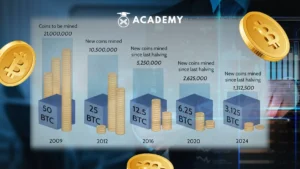Bitcoin prices often cause a stir because they sometimes increase drastically, making many people suddenly curious. However, once you start digging deeper, one question will definitely arise: “Actually, how many Bitcoins are there in the world?”
This question is not just about numbers. Behind it, there is a hidden reason why Bitcoin is considered the rarest and most valuable digital asset.
Because unlike regular money that can be printed continuously, Bitcoin has a definite limit. And every second, we are getting closer to that limit.
The more limited the amount, the greater the appeal. This is what makes many investors and observers believe that Bitcoin has long-term potential.
However, to truly understand how important its scarcity is, you need to know the facts about how much has been mined, how much has been lost, and when the maximum amount will be reached.
Now, before you miss out on an important understanding of this asset, let’s dissect all the data clearly and simply. Who knows, after this, you will understand better why Bitcoin is not just a hype.
Also read related articles: Getting to Know Satoshi Nakamoto, the Inventor of Bitcoin
How Many Bitcoins Are There in the World

Bitcoin was designed by its creator using the pseudonym Satoshi Nakamoto with a maximum supply that was set from the start, which was 21,000,000 units. This number is fixed and cannot be increased.
Unlike fiat currencies that can be printed without limit by monetary authorities, Bitcoin adopts a system known as deflation, where the supply is limited and its value has the potential to increase as demand grows.
This maximum limit was not a decision taken carelessly. Satoshi chose the number 21,000,000 with the aim that Bitcoin would still have a high value and be widely used, even if its scale reached a global level of use.
With a limited amount, one Bitcoin can be divided up to the smallest unit called a satoshi (0.00000001 BTC), making it flexible enough for various economic scenarios.
This mechanism is also a form of provable scarcity, where everyone in the network can verify that the maximum number of Bitcoins will never exceed that number.
In fact, changing the 21,000,000 limit would require a majority consensus of the entire Bitcoin network—a feat that is extremely difficult given its decentralized nature and thousands of nodes around the world.
Thus, the number 21,000,000 is not just a symbol, but a key pillar that sets Bitcoin apart from traditional financial systems—a scarce digital asset designed to be resistant to inflation and supply manipulation.
You might also like: How Long Does It Take to Mine 1 BTC? Here’s the Most Realistic Answer!
How Many Bitcoins Have Been Mined So Far?
As of July 2025, the number of Bitcoins that have been successfully mined has exceeded 19,700,000 coins. This means that more than 93% of the total maximum supply of 21,000,000 BTC is now circulating in the market.
Although it sounds almost complete, the mining process is far from over. The remaining 2,000,000 BTC are not expected to be fully mined until 2140.
This is because Bitcoin’s mechanism is designed to slow down the rate of new coin creation through a system called halving.
Initially, when the Bitcoin network was launched in 2009, the reward for miners who successfully completed a block of transactions was 50 BTC.
This amount was then halved every four years, to 25 BTC in 2012, then 12.5 BTC in 2016, and to 6.25 BTC at the third halving in 2020.
In May 2024, the reward amount was again reduced to just 3.125 BTC per block.
With an average mining time of one block every 10 minutes, currently around 900 BTC are minted every day, or around 328,500 BTC per year. This rate gives an annual inflation rate of around 1.7%.
After the last bitcoin halving, annual inflation is expected to drop to below 0.85%, reflecting increasing scarcity.
It should be noted that of the amount of BTC that has been mined, not all of it is actually in circulation. Some coins are permanently lost, for example because the owner forgets access to a digital wallet or loses the private key.
This has been considered by Bitcoin’s creator, Satoshi Nakamoto, who stated that lost coins actually increase scarcity and, ultimately, add value to the remaining coins.
If you want to monitor real-time data on the number of Bitcoins in circulation, you can access it via Blockchain.com Explorer.
Another interesting article for you: How to Mine Bitcoin for Free for Beginners
Why is Mining Getting Slower?
The Bitcoin mining process is slowing down due to the halving mechanism, which is a halving of the reward for miners every four years. When it was first launched in 2009, the reward per block was 50 BTC.
However, since then, its value has continued to decline: to 25 BTC in 2012, 12.5 BTC in 2016, then 6.25 BTC in 2020.
After the last halving in May 2024, the miner’s reward is now only 3.125 BTC for each successfully mined block. This number will continue to decrease over time, until it reaches zero around 2140.
After that point, no new Bitcoins will be minted, and miners will only be paid transaction fees.
With this system, the rate of Bitcoin supply is slowing down. This makes Bitcoin increasingly rare, and because of its scarcity, its value can continue to increase over time.
How Many Bitcoins Have Been Lost?
According to data from Chainalysis and Glassnode, an estimated 2,000,000 to 4,000,000 Bitcoins have been permanently lost.
This loss occurs for various reasons, such as the owner forgetting the private key, damage to the digital wallet storage device, or even dying without leaving access to the asset.
With a maximum total Bitcoin supply of only 21,000,000, this number certainly has a big impact.
If the number lost reaches 4,000,000 BTC, then the number of Bitcoins that can actually be used is likely to be less than 18,000,000.
This makes Bitcoin increasingly rare, and this scarcity is what strengthens its appeal and value in the eyes of many investors.
Still on this topic, also see: Who is the Largest Bitcoin Holder? Find Out Here!
Bitcoin Distribution: Who Holds It?

Bitcoin ownership is spread across a wide range of people, from large institutions to individual users. Several well-known companies such as Tesla and MicroStrategy are known to hold thousands of BTC as part of their financial strategy.
In addition, there are also whales, namely wallet owners with thousands of Bitcoins, who are usually early investors or individuals with large capital strength.
On the other hand, retail traders like you and me also take part in this ecosystem, although with much smaller ownership.
However, data from CoinMarketCap shows that Bitcoin distribution is still uneven.
Around 10,000 wallet addresses control more than half of the total circulating supply, reflecting a fairly large concentration of ownership in the hands of a few parties.
The Impact of Limited Supply on Investors & Price
One of Bitcoin’s main strengths lies in its permanently limited supply. With a maximum of only 21,000,000 coins, there will never be any additional Bitcoins created once this limit is reached.
This system is different from fiat currencies that can be printed by central banks without limit as monetary policy requires.
It is precisely because of its deflationary and programmed nature that Bitcoin has become increasingly popular as a long-term store of value. For investors, Bitcoin’s scarcity creates its own appeal.
When demand rises, especially after the approval of a Bitcoin ETF, while the number of coins remains fixed and some are permanently lost, price pressure tends to increase.
Simple economic principles apply here, namely when demand is greater than supply, prices will rise. That is why many investors have dubbed Bitcoin as digital gold.
Like gold, Bitcoin cannot be produced at will, has a limited mining process, and is not dependent on government policy.
Moreover, Bitcoin is also easy to move, divide, and store digitally, making it a modern alternative to precious metals in the global financial world.
Price pressure will increase in the future as there are fewer Bitcoins left to mine and more people want to own them.
Currently, most Bitcoins are in the wallets of long-term investors, and only a small portion is actively traded on the market.
So, as we get closer to the 21,000,000 coin limit and if demand remains high or even increases, the price of Bitcoin will likely continue to rise.
For investors, this makes Bitcoin an asset that is not only speculative, but also strategic in diversifying a long-term portfolio.
What Happens After All BTC Are Mined?
When all 21,000,000 Bitcoins have been mined (estimated to be around 2140), no new BTC will be created. However, the Bitcoin network will continue to run as usual.
Miners will still play a vital role in maintaining security and validating transactions, but they will no longer receive rewards in the form of new coins.
Instead, the incentive for miners comes entirely from the transaction fees that users pay when sending Bitcoin.
That way, even if the coin creation process stops, mining activity continues to maintain the continuity and security of the system.
Conclusion: Bitcoin is Scarce, and That’s Its Main Strength
Well, that was an interesting discussion about the Number of Bitcoins in the World: Only This Much is Left! which you can read in full at the Crypto Academy at INDODAX Academy.
In conclusion, Bitcoin is not just an ordinary digital asset. It is designed with a deflationary system, is transparent, and cannot be printed at will like fiat money.
Of the total 21,000,000 BTC that could exist, the majority have been mined, and millions of them have even been permanently lost.
So, if you are still waiting for the price to drop sharply before buying, remember that the supply of Bitcoin will not increase, while demand continues to rise.
This scarcity is the source of its value and also the reason why Bitcoin continues to be hunted to this day.
In addition to expanding your insight into the world of investment, you can also stay updated with the latest crypto news and monitor the price movements of digital assets directly on the INDODAX Market. Don’t forget to activate notifications so that you always get the latest information about digital assets and blockchain technology only at INDODAX Academy.
You can also follow our latest news via Google News for faster and more reliable access to information. For an easy and safe trading experience, download the best crypto application from INDODAX on the App Store or Google Play Store.
Also maximize your crypto assets with the INDODAX Earn feature, a practical way to earn passive income from the assets you store.
Also follow our social media here: Instagram, X, Youtube & Telegram
FAQ
1.What is the maximum total number of Bitcoins in the world?
Only 21,000,000 BTC. This number cannot be increased or changed.
2.How many Bitcoins are currently in circulation?
More than 19,700,000 BTC have been mined as of July 2025.
3.Why are some Bitcoins lost?
Due to lost wallet access, forgotten private keys, or damaged wallets. Estimates: 2,000,000–4,000,000 BTC lost forever.
4.When will all Bitcoins be mined?
Estimated in 2140, as mining rewards continue to shrink due to halving.
5.What will be the impact if all Bitcoins have been mined?
Miners only get transaction fees, and Bitcoins become increasingly rare — high potential added value.
Author: Boy





 Polkadot 9.23%
Polkadot 9.23%
 BNB 0.57%
BNB 0.57%
 Solana 4.89%
Solana 4.89%
 Ethereum 2.37%
Ethereum 2.37%
 Cardano 1.22%
Cardano 1.22%
 Polygon Ecosystem Token 2.17%
Polygon Ecosystem Token 2.17%
 Tron 2.83%
Tron 2.83%
 Market
Market


